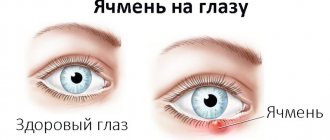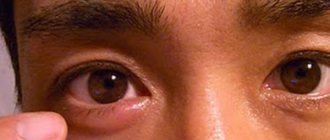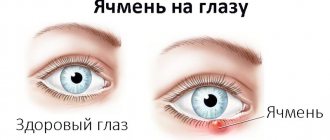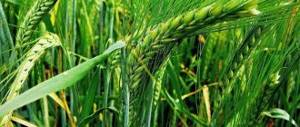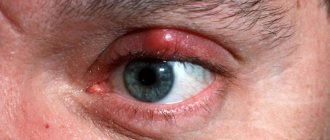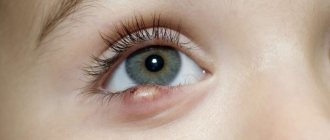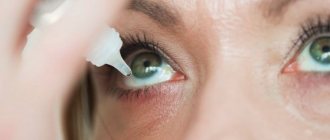- This is a swelling on the eyelid, usually having a white or yellow purulent head. From a medical point of view, barley is an acute purulent inflammation of the hair follicle of the eyelash or the mouth of the sebaceous gland.
Barley is a popular name, but when a doctor makes a diagnosis, he will write it as hordeolum .
There are external and internal barley. External stye
- This is a classic situation when the stye is on the outside of the eyelid.
Internal stye
is located on the mucous membrane of the eyelid; in this case, a lobe of the meibomian gland (the fatty gland of the cartilaginous plate of the eyelid) becomes inflamed.
How to treat stye
The appearance of an inflamed lump on the eye is usually associated with bacteria or hypothermia; in more rare cases, this pathology is caused by a skin mite.
If the appearance of the disease is noted on the upper eyelid, then this type of stye is not as dangerous as on the lower part of the eyelid. In appearance it looks like an abscess or pimple. At the same time, it becomes noticeable that the eyelid with stye swells and turns red, and the inflammation itself causes pain, especially when touched.
After a few days, the inflammatory process begins to subside and the pus comes out. To help the eyelid, you can carefully treat the affected area with iodine, avoiding getting the product into the eye.
The appearance of an abscess on the lower eyelid can also be due to the penetration of bacteria or an inflammatory process in the glands - this reason is less common, but is more serious.
Sometimes the eye becomes very swollen and red, along with this, headaches and painful sensations in the stye area may appear. Also, in rare cases, during an inflammatory process in the lower eyelid, the temperature may rise slightly.
At the initial stage of maturation of the abscess (this happens in the first couple of days), a person feels itching and literally feels how the lump is growing. At this time, it is best to lubricate the affected area of the eyelid with solutions containing iodine or ethyl alcohol. Calendula tincture or brilliant green works well.
But the main thing in this case is extreme caution, since getting the medicine into the eye will cause a severe burning sensation. And can even damage the mucous membrane
Manipulations need to be done using a cotton swab: it must be moistened in the selected solution and the stye must be treated with a pointed motion, pulling the eyelid away from the eye.
In addition to the above-mentioned therapy, it is advisable to use the help of other pharmaceutical drugs aimed at eliminating bacteria. Today in the pharmacy you can find special ointments or eye drops with an antibacterial effect.
For example, the drug "Floxal" is available in pharmacies, both in the form of ointments and in the form of drops. It is recommended to use it for the appearance of styes, conjunctivitis and other similar pathologies.
The drug copes well with most microorganisms. You can use both drops and ointment at the same time: first, in this case, 1 drop of medicine is dripped into the eye, then the ointment is applied behind the eyelid. It is advisable to repeat the manipulations 2-3 times a day for at least a week. It is noted that already on the second or third day, barley becomes less noticeable and discomfort with itching disappears.
The effect of the drug "Uniflox" is exactly the same: it is used in the treatment of various bacterial eye infections or as a prophylactic agent. Available in the form of drops, which need to be used up to eight times a day for three days. At first, it is advisable to carry out the procedure every hour, increasing the interval over time.
Lotions with herbal infusions also help a lot. To reduce inflammation in the eye, it is recommended to use an infusion of chamomile or calendula. Moisten a cotton pad in the prepared solution at room temperature and apply it to the affected eye. Hold the lotion for about ten minutes, repeat manipulations every 1.5-2 hours until swelling and inflammation begin to decrease.
When barley appears, you should not make warming compresses - this promotes greater proliferation of bacteria and, accordingly, inflammation may increase. Also, in no case should you open a purulent lump on the eye yourself using improvised means, since this method will not only bring the infection inside (which can lead to other serious consequences), but will also contribute to the possible appearance of meningitis, the penetration of pus into the eye socket and the development of acute diseases.
Self-squeezing can lead to complications such as thrombosis, blood poisoning, eyelid abscess and some other complications.
If treatment turns out to be ineffective, it is better to consult a doctor for help: in the case of stye that persists and does not disappear for two weeks, the doctor may suggest surgical intervention.
Causes of stye in the eye area
An inflammatory process on the eyelid, which soon turns out to be barley, often appears due to a bacterial infection that has become active in the baby’s body. It is believed that the main culprit of inflammation is Staphylococcus aureus, which wakes up from various factors, regardless of the child’s age, but there are also other main reasons:
- Baby's dirty hands. After each visit to the street and, naturally, to the toilet, it is necessary to wash your hands with soap, since small children very often rub their eyes, and infection enters the eyes through unwashed palms. Both adults and children need to develop the habit of washing their hands regularly. By observing basic hygiene rules, we protect our eyes from pathogenic infections.
- The second reason for the frequent occurrence of barley is weakened immunity. The basis of health is a balanced diet and regular exercise. These actions will increase resistance to the disease. In the off-season, vitamins should be added to the diet to boost immunity. A lack of essential vitamins and microelements can also cause an inflammatory process.
- Barley quite often coexists with diseases associated with problems of the gastrointestinal tract and metabolism, because they, in turn, often cause vitamin deficiency in the body and, as a result, weakened immunity.
- In older children, barley may “pop out” during a period of hormonal changes, since during the restructuring of the endocrine system, clogging of the sebaceous glands may occur in front of the child’s eyes.
- Getting a foreign body into the eyes, for example, eyelashes or specks.
- Long walks in bad weather: rain, severe frost or gusty wind, especially if you walk against the wind for a long time. Hypothermia from prolonged exposure of a child to water is also not recommended.
- Overwork, too much physical and mental stress for the child, as well as lack of sleep.
- Environmental problems: smoke, air pollution, chemical emissions.
At the first signs of the appearance of barley, it is necessary to find out the cause of inflammation and eliminate it. The disease is not pleasant and causes a lot of discomfort. Especially in the case of very young children, to whom it is difficult to explain why they should not touch or rub their sore eyes.
Varieties of barley
Young children under one year of age often develop a fever, which is also a reason to immediately visit a specialist. Internal styes are removed only by specialists to avoid pus getting into the eyes.
There are two types of this disease: internal and external. When the hair follicle of the eyelash or the sebaceous gland of Celsus located around it is inflamed, we can talk about the appearance of external barley. Internal stye occurs when a lobule of the meibomian gland becomes inflamed and an abscess appears inside the eyelid.
Most often, stye occurs on the upper eyelid and is accompanied by swelling that spreads over the entire surface of the eye. It develops very quickly and the baby will most likely complain of burning and itching around the eye, which can be noticed by the child’s frequent touching of the eye and the constant desire to scratch it, and when pressing on the site of the future stye, pain will occur.
The swelling that appears on the inflamed eyelid will initially look like a small and dense tubercle, which over time will increase in size, turning into an abscess. The duration of the disease varies from person to person. In most cases, the stye opens on the fifth day. There are cases when the tubercle resolves on its own and pus can come out of it. If this causes the child’s eyelids to stick together, you can blot the area of inflammation with a solution of furatsilin.
An abscess that appears inside the eyelid is quite dangerous: you need to carefully monitor it, because if it breaks inside, the infection can get inside the eye socket.
There is also cold barley, which does not disappear for a long time and looks like a dense lump. This tumor does not disappear on its own, so visiting a doctor would be the best decision.
How to get rid of stye under the eye?
Hordeolum can be treated with medications or folk recipes at home. It is possible to do without a visit to the doctor only in the first stages of the disease
It is only important to understand that the danger of self-treatment lies in an incorrectly chosen method of therapy or an erroneous diagnosis. Only the exclusion of serious diseases of the eyelid (cyst, tumor, chalazion) makes it possible to carry out suitable therapy
Drops containing antibiotics are an excellent assistant in treating the disease. For example, gentamicin, albucid, erythromycin or penicillin solution. If you regularly drip them into the inflamed eye (5 times a day), you can completely eliminate the formation of an abscess.
Tetracycline, erythromycin or hydrocortisone ointment has a similar effect. It is better to place them behind the edge of the lower eyelid overnight to avoid discomfort from the possible temporary appearance of blurred vision. This procedure should be performed after thoroughly washing your hands. To apply the ointment, you need to squeeze a small amount onto your index finger or little finger, then pull back the lower eyelid and carefully place the medicine behind it.
To prevent the appearance of an abscess, you can wipe the itchy area with an alcohol wipe, avoiding contact with the eyes and mucous membranes. You can use iodine, calendula solution or brilliant green instead of alcohol.
It should be remembered that opening barley on your own is prohibited. This action provokes the spread of infection, affecting the entire eyelid, and sometimes promotes the penetration of bacteria into the orbit.
How to apply ointment correctly?
Antibacterial ointment for the treatment of stye can be applied a couple of times a day. But most often, patients apply it once at night, since this use of the drug is the most convenient.
There are several rules:
Antibacterial ointment must be stored in the refrigerator. This must be done so that the effectiveness of the drug does not decrease. Before use, wash your hands thoroughly with soap. It is advisable not to touch the tubercle with your hands. The product should be applied to the pathological formation using a cotton swab or cotton pad in a thick layer.
Traditional methods
Traditional methods of treating stye at home are very popular among patients of any age, but few know that the use of various ointments, compresses and lotions for this disease is undesirable due to the high risk of spreading the infection to surrounding tissues. The following remedies should only be used as a last resort if immediate medical attention is not possible. If any side effects occur (pain, burning, itching, decreased visual acuity), the eyes should be rinsed generously with cool running water and stop using alternative methods of treatment.
Warming up with an egg
This is the most accessible and popular way to treat hordeolum on the eye at home, but it can only be used if there is no pus in the lump (that is, until 2-3 days of illness). A chicken egg must be boiled and, without peeling, wrapped in a piece of light cloth, and then applied to the painful area. Keep the compress until it cools completely. Repeat 3-4 times during the day.
Chicken eggs for the treatment of barley
Hot potato compress
Like hot egg compresses, this method can be used strictly at the stage of a painful point or swelling (before the formation of an abscess). Boil potatoes in their skins, mash with a fork or masher, wrap in gauze and apply to the inflamed eyelid. Hold until the heat disappears. You need to repeat the procedure 4-5 times on the first day. Starting from the second day, you can use hot potato compresses 3-4 times a day.
Hot potato compress
Lotions with aloe gel
Aloe gel contains a huge amount of vitamins and natural substances that have anti-inflammatory, analgesic and bactericidal effects. The gel cannot be used in its pure form, as if used carelessly there is a high risk of damage to the mucous membrane of the eye. To use, you need to mix ½ teaspoon of gel with two tablespoons of warm boiled water. Moisten a cotton swab generously with the resulting liquid and, after squeezing lightly, apply it to the inflamed eyelid for 5 minutes. Use for 5-7 days up to 4 times a day.
Aloe gel
Tea compress
A compress made from used tea bags has been used for decades to combat inflammatory eye diseases. To deal with barley at an early stage, tea leaves should be applied to the bud before they cool. If an abscess has already formed on the eye, on the contrary, before using the tea leaves, you need to keep it in the refrigerator for a while. Use 2-3 times a day.
Tea bag
Lotions with medicinal herbs
Oak bark
Various decoctions and infusions of medicinal herbs and plants have a quick healing effect for barley.
They can be used at any stage of the disease, including purulent inflammation, but it is important to prevent pus from getting into other tissues of the eye. The following plants have pronounced anti-inflammatory, disinfectant and soothing properties:
- Oak bark;
- linden flowers;
- chamomile flowers;
- calendula;
- sage;
- oregano;
- thyme.
Tincture of calendula
Is it possible to smear barley with brilliant green or iodine?
To destroy microorganisms that multiply in the resulting tubercle, cauterization is used with brilliant green, iodine or alcohol. To do this, very carefully lubricate the formation with a cotton swab dipped in one of these solutions.
It is important not to lubricate too much and try to spot treat the inflammation. Otherwise, you can burn the delicate mucous membrane of the eye.
Also, the eye must be closed during the procedure.
Many people have encountered such a “surprise” as stye on the eye. Swelling and a very painful grain called stye appears on the eyelid. The methods that are used in everyday life to treat it are very different - from urine therapy to brilliant green. What exactly is stye, and how to treat it correctly?
The content of the article:
Stye on the eye. What it is? Causes of stye on the eye What is the danger of stye on the eye? Treatment of stye on the eye Folk remedies for the treatment of stye Stye on the eye. What you absolutely cannot do Treatment of stye. Dispelling myths Important recommendations for treating stye
Symptoms of stye
Barley is an infectious disease that occurs from inflammation of the gland in the upper eyelid. The resulting red lump not only looks unsightly, but also causes pain.
In order not to confuse stye with other diseases of the eyelid and to carry out treatment effectively, you need to know about the main signs and symptoms:
- inflamed seal on the edge of the eyelid (both upper and lower);
- the appearance of redness;
- swelling on the eyelid;
- clear discharge from the eye;
- pain or burning in the area of tubercle formation;
- feeling that a foreign object has entered the eye;
- weighting or drooping of the eyelid;
- decreased visual acuity.
As soon as you notice the first symptoms, you need to start treatment immediately - otherwise the affected area may begin to fester and you will have to contact a surgeon. Moreover, if not treated in a timely manner, foci of inflammation may appear in other parts of the eye. The inflammatory process is easiest to stop at an early stage.
When stye appears, you should absolutely not touch your eyes with dirty hands or use decorative cosmetics. You should also stop using contact lenses. And do not forget that inflammation can be transmitted to the rest of the household - so use your own towel and even utensils.
Interesting: Bags under the eyes: causes and how to get rid of them
What it is?
- 7.1 Video - Quick treatment of stye
Barley (hordeolum)
Hordeolum (popular name - barley) is a purulent lump that forms on the outer or inner eyelid as a result of inflammation of the hair follicle , which contains the root of the eyelash and its bulb, or the adjacent sebaceous glands. At the beginning of the inflammatory process, a painful point appears at the site of the lesion, which swells after 2-3 days, and in its place a dense lump is formed, filled with a serous-purulent liquid of a whitish, creamy or yellowish color. When pressing on the lump, not only pus, but also particles of dead epithelium can be separated from it.
Inflammatory diseases
Depending on the location of the pathological process, three clinical forms of barley are distinguished.
Table. Varieties of barley.
| Name | Localization of the inflammatory process | Peculiarities |
| Hordeolum (external stye) | Most often, the hair follicle becomes inflamed, the shell of which contains the ciliary bulb, which is responsible for the growth and nutrition of eyelashes on the eye. Simultaneously with the follicle, the Zeiss gland adjacent to the hair follicle may also become inflamed. | It has the most acute and painful course. With multiple rashes, the disease can manifest itself not only with local symptoms, but also with general intoxication of the body. |
| Meibomite (domestic stye) | The inflammatory process involves the meibomian glands, which consist of many alveoli and produce a viscous secretion into the common lacrimal duct. The Meibomian glands, unlike the Zeiss glands, are located on the inside of the eyelid, so their inflammation is called internal stye. | It has a less acute course compared to external inflammation, but this form is also quite painful and is accompanied by symptoms typical of this group of diseases (pain, burning, redness and swelling of the conjunctiva, etc.). |
| Chalazion (in some sources - chalazion) | It is characterized by chronic inflammation not of the glands themselves, but of the cartilage fiber located around them. | Chronic inflammation of the cartilage around the meibomian glands develops with a stable weakening of the immune system. A distinctive feature of a chalazion is the absence of discomfort and pain (in most cases, a lump on the eye is only a cosmetic defect). |
Chalazion - what is it?
Treatment of the disease
If these measures do not help and the stye continues to develop, it is recommended to consult a doctor. This disease cannot be considered simple and does not deserve special attention, which can be easily dealt with at home, since in some cases it can provoke serious complications.
You should definitely visit a doctor if the temperature rises, the lymph nodes are enlarged, other signs of intoxication appear, the abscess causes discomfort or has broken out towards the eye, and also if the stye has gone away but has recurred after some time.
You should seek medical help in situations where the body temperature begins to rise, a tumor forms, or if the stye has gone away, but after a while it reappears.
Preparations for barley
The doctor selects a comprehensive treatment that helps fight styes on the eye and at the same time improves the general condition of the patient.
If the pus still does not come out, it is recommended to use antibacterial agents (primarily eye drops): Albucid, Gentamicin, Levomycetin, Sofradex. They prevent the inflammatory process and are very effective when barley is just maturing. The products are used up to 5-6 times a day.
At night you need to put antibacterial ointments (hydrocortisone, tetracycline, erythromycin) behind the eyelid, in this case the effect on bacteria will be long-lasting. If barley does not go away for a long time and forms additional ulcers, it is necessary to use systemic agents - amoxiclav, doxycycline.
As soon as the abscess is opened, it is necessary to wash the inflamed area with furatsilin or sodium sulfacyl to completely remove the pus and prevent the infection from spreading.
If you have a fever, fever, you can take medications like paracetamol or aspirin. It is also recommended to support the general immunity of the body with vitamin complexes and immunomodulatory agents.
Before using medications, it is advisable to consult a doctor so as not to cause harm by choosing the wrong medication.
Additional procedures
Warm compresses can be used simultaneously with drug treatment. Dry heat is recommended - you can use special medical devices, you can make do with improvised methods - a warm boiled egg, heated bags of salt.
It is also worth trying these methods:
- You need to heat the flax seeds in a frying pan, wrap them in a cloth or handkerchief, and then apply them to the site of inflammation.
- Cut the onion into two parts and bake in the oven. Wrap one half in cloth and apply to the sore eyelid.
Treatment in this way can only be done in the early stages of the disease. As soon as the abscess begins to break out, dry heat must be abandoned, otherwise the stye may burst, the pus will fall on the mucous membrane of the eye and cause an infection.
Folk remedies
There are a very large number of traditional medicine recipes on how to get rid of pisyak, as barley is popularly called. You can cut a clove of garlic in half, squeeze a little juice onto a cotton swab and treat the inflammation
This should be done 3-4 times a day with great care so as not to burn the skin and mucous membrane of the eye.
In addition, there are several recipes for herbal lotions.
- Grind dill or coriander seeds, then pour boiling water over them and let cool. Apply lotions several times a day.
- Pour boiled water over an aloe leaf for a day. Wipe the inflamed area with the resulting infusion 6-7 times a day.
- 1 tbsp. l. Pour boiling water over dried cornflower flowers and strain after half an hour.
- Pour boiling water over dried calendula flowers and boil for 10 minutes. Wrap up and leave for an hour.
- Boil fresh plantain leaves for 10 minutes, cool.
- Pour boiling water over chamomile or bird cherry leaves, simmer in a water bath for about 20 minutes, let cool.
- Brew 6–7 dried clove flowers in 1/3 cup boiling water.
You can also use other recipes for compresses. The following methods against barley have proven themselves very well:
- Wash the lilac leaves and pass through a meat grinder. Tie the resulting pulp in cloth or gauze and keep it on the inflamed eyelid for about half an hour.
- Cut the potatoes into cubes and wipe the affected area with them.
- Boil the crumb of white bread in milk, strain and apply the bread in gauze to the place where the barley appeared.
- Castro oil helps with inflammation. It needs to be heated and applied to the eyelid as an ointment.
- Make a tincture of chamomile flowers, strain out the leaves and apply the paste to the eye.
Causes of inflammation
Barley is an infectious-inflammatory disease that develops when pyogenic (capable of producing pus) bacteria enter the mucous membranes of the eye. In almost 80% of cases, the pathogenic flora in hordeolum is represented by bacteria of the Staphylococcaceae family, specifically Staphylococcus aureus. These are gram-positive bacilli, widely distributed in the air, soil, and are also normal representatives of human microflora. Barley on the eye can be caused by pathogenic and opportunistic strains of staphylococci that secrete toxins and various enzymes that not only disrupt the functioning of cells, but in rare cases can change their structure.
Staphylococcus aureus
In large quantities, opportunistic colonies of staphylococci inhabit the mucous membranes of the respiratory tract, oral cavity, nasal passages and skin, so barley is often a complication of previous diseases of the nasopharynx and oropharynx: sinusitis, tonsillitis, tonsillitis, pharyngitis. Other bacterial forms of hordeolum are possible when infected by hematogenous or lymphogenous routes from other sites of infection, for example, in diseases of the gastrointestinal tract. Mixed types of bacterial flora are rarely found, which, in addition to staphylococci, can also be represented by gonococci, streptococci, and some types of viruses or fungi.
Chronic or recurrent barley often occurs with helminthiasis, parasitic diseases or pathologies of the endocrine system, for example, diabetes mellitus.
What contributes to the emergence
Note! An important factor influencing the risks of infectious and inflammatory eye diseases is personal hygiene, hygiene of the hand and the surrounding area, therefore the main risk group includes mainly children of preschool and primary school age (up to 10 years).
How to quickly treat internal stye?
At an early stage of the disease, doctors advise following the following tips:
- Provide a warm, dry environment for the affected eye. It is best to warm the eyelids with a lamp with a blue light spectrum or UHF. Wet dressings are not recommended to avoid the spread of infection.
- Instill drops that will kill bacteria. These may be the drugs "Floxal" or "Tsiprolet". For the same purposes, ointments that have an additional anti-inflammatory effect are suitable: “Tetracycline”, “Hydrocortisone”, “Tobradex”. These drugs can be recognized from photographs on the Internet.
If the barley has already ripened, you need to resort to additional measures:
- Avoid using cosmetics and contact lenses for a while. Rinse your eyes daily with filtered water and wash your hands often with soap.
- A medical professional should treat the eyelid with a disinfection solution to help avoid burns to the eye shell.
- According to the recommendations of the attending physician, you can also resort to drip infusion of solutions of penicillin or erythromycin, albucid, hormonal drops with hydrocortisone.
- The inside of the eyelid can be lubricated with ointments containing antibiotics or sulfonamides, as well as yellow mercury ointment.
When treating styes on the inside of the lower and upper eyelids at home, you can also resort to traditional medicine, but only after consultation with a doctor. In addition to pharmaceuticals, it is worth recommending a lotion made from aloe leaves or calendula flowers. However, it is still not worth actively engaging in independent treatment, since the spread of infection can lead to serious consequences requiring surgical intervention. Timely contact with a specialist and professional therapy will help get rid of internal stye within a few days.
Did you like the post?
Rate it - click on the stars!
Confirm rating
Article rating / 5. Votes:
How long to use antibacterial ointment?
Antibiotic ointment is used to treat stye once or twice a day. But most often they are used once a day, usually before bed. Barley is an acute disease and in the first days it is recommended to use the drug more often. For prevention, you can smear both eyes at once.
The product must be used before the tubercle is opened. But to prevent re-infection after opening the tubercle, it is recommended to continue use for another one or two days.
Eye drops for stye - what are they?
Using medications, a person will cure stye on the eye in 3-4 days; without treatment, the process of its ripening will last more than a week. Drops from barley on the eye in children and adults have a milder effect than ointments. To eliminate this problem, experts recommend using eye medications from the following brands:
- Phloxal.
- Tobrex.
- Albucid.
- Levomycetin.
Some of the medications listed include drugs that contain antibiotics. Such drugs are used exclusively as prescribed by a doctor, if complications occur or there is no positive result from the treatment.
Using Tobrex - pros and cons
The appearance of an inflammatory abscess on the eyelid is neutralized by the drug Tobrex. Drops have the following number of indicators:
- gentle effect on the affected areas;
- relieving pain, swelling, redness;
- accelerating the process of barley ripening;
- can be used for patients of all age categories;
- comfortable price.
Doctors prescribe this drug specifically for children. It acts on the problem area gently, does not cause discomfort, eliminates unpleasant symptoms of the disease, and helps speed up recovery. Children should instill 1 drop of the product three times a day; for adults this dose is 3-4 drops 3-6 times a day.
Application of Floxal
Floxal drops are a powerful antibiotic. Their price is higher than other products, but their effectiveness is higher. They are prescribed by doctors if they have to deal with advanced cases. The drug should not be used for more than a week; the dosage should be determined by a doctor. The product is freely available, before purchasing, consultation with a doctor is required, because antibiotics are not indicated in all cases. These eye antibiotics in drops have a number of qualities:
- eliminating the root cause of barley;
- getting rid of external signs of the problem;
- complete relief of discomfort and pain;
- mild effect on the retina.
The patient will be able to apply the drug directly from the bottle, because it already has a special dispenser.
Treatment with Albucid
Sulfacyl sodium or Albucid are eye drops designed to eliminate inflammatory manifestations. Ophthalmologists attribute it to people who have stye on their eyelids. The drug is used for children and adults and has the following qualities:
- eliminates pain;
- has a gentle effect on the eye;
- relieves redness and swelling;
- helps accelerate the maturation of a purulent abscess.
Adults should use the product six times a day, using 2-3 drops with each application.
Fighting barley with Levomycetin
Levomycetin drops are a product containing antibiotic substances. Used as prescribed by a doctor. Accelerates the process of releasing pus from the capsule and promotes wound healing. The drug relieves pain and redness, shortens the treatment process to 3-4 days, has a gentle effect, and is inexpensive.
Drops for barley on the eye during pregnancy should be prescribed by a doctor. Independent use of the drug throughout the entire period of pregnancy is prohibited. Only a specialist can correctly determine the dosage for a woman.
What you should not do under any circumstances
Stye on the eye - what not to do: wear contact lenses; scratching your eyes with dirty hands; use cosmetics; open the abscess yourself; heat over steam; warm up ripening barley; cover with adhesive tape.
If this is not done, then the pus from the ripened barley may not come out, but on the contrary, which will lead to the development of sepsis. An infection that enters the blood quickly spreads throughout the body. There are known cases of a patient developing meningitis as a result of self-squeezing of an abscess.
Diagnosis of pathology
Often, frozen barley or chalazion is formed as a result of infection in ordinary barley or is the result of uncontrolled cell growth, as in a tumor (this option for the appearance of pathology is very rare).
Other causes of the disease:
- hypothermia of the body while swimming in cold water, especially in winter;
- decreased immunity;
- chronic nature of colds;
- failure to comply with personal hygiene standards;
- constant use of contact lenses;
- dysfunction of the gastrointestinal tract;
- failure of hormonal levels;
- impaired motility of the biliary tract.
The first sign of the disease is the appearance of a neoplasm in the form of a dense lump on the eyelid. The skin in this area turns red and upon visual inspection you can notice an accumulation of pus in the center of the swelling. Touching the inflamed area causes pain.
The development of the disease occurs within two weeks. The inflamed formation gradually increases in size during this period, which significantly reduces the quality of life and causes some discomfort in a person. With large hailstones, pressure on the eye increases, which can lead to deterioration in vision function.
At the initial stage of the pathology, a person may not notice it at all and discover it only during a random examination of the eyelid. With further enlargement of the chalazion, it is already visible to the naked eye; to the touch it represents a compacted, mobile neoplasm the size of a grain of wheat. The inflammatory process of pathology can occur in case of untimely treatment of the initial stage of the disease and ultimately leads to a significant increase in the size of the formation with subsequent deformation of the eyelid and increased pressure on the eyeball.
- An immunogram is performed to determine the state of the body’s immune system in order to normalize its functioning.
- Skin scraping and examination of eyelashes for the presence of mites, this requires 4 eyelashes from each eye, scraping from the eyelid and analysis of the contents of various types of pimples.
- A culture is carried out to detect staphylococcus, since it is often the main cause of a purulent infection.
- A general blood test to identify other inflammatory processes in the body that contribute to the recurrence of frozen barley.
- An analysis to determine the level of sugar in the blood, the increased content of which can cause dysfunction of peripheral vessels, which further disrupts the normal process of blood circulation and leads to an increase in foci of inflammation.
If the underlying disease that causes the formation of repeated manifestations of chalazion is identified, the problem with relapses will disappear by itself and the inflammation will go away naturally.
Why barley is dangerous - consequences and traces
It is not the stye itself that is dangerous, but its improper treatment - heating, urine therapy, squeezing out pus, etc. These actions can lead to infection in the blood, which, in turn, can cause:
Meningitis. Sepsis.
It is also worth noting that a stye is sometimes confused with a cystic neoplasm or chalazion. If the diagnosis is made incorrectly and independently, then incorrect treatment is carried out, which greatly aggravates the problem. Therefore, if barley is accompanied by an increase in temperature, and the swelling itself grows in size and becomes an obstacle to vision, then seeing a doctor is the only option.
Treatment principle
Hordeolum can be treated with medications or folk recipes at home. It is possible to do without a visit to the doctor only in the first stages of the disease.
It is only important to understand that the danger of self-treatment lies in an incorrectly chosen method of therapy or an erroneous diagnosis. Only the exclusion of serious diseases of the eyelid (cyst, tumor, chalazion) makes it possible to carry out suitable therapy
Drops containing antibiotics are an excellent assistant in treating the disease. For example, gentamicin, albucid, erythromycin or penicillin solution. If you regularly drip them into the inflamed eye (5 times a day), you can completely eliminate the formation of an abscess.
Tetracycline, erythromycin or hydrocortisone ointment has a similar effect. It is better to place them behind the edge of the lower eyelid overnight to avoid discomfort from the possible temporary appearance of blurred vision.
This procedure should be performed after thoroughly washing your hands. To apply the ointment, you need to squeeze a small amount onto your index finger or little finger, then pull back the lower eyelid and carefully place the medicine behind it.
To prevent the appearance of an abscess, you can wipe the itchy area with an alcohol wipe, avoiding contact with the eyes and mucous membranes. You can use iodine, calendula solution or brilliant green instead of alcohol. It should be remembered that opening barley on your own is prohibited.
This action provokes the spread of infection, affecting the entire eyelid, and sometimes promotes the penetration of bacteria into the orbit.
Briefly about prevention
The main prevention of barley is strict adherence to the rules of personal hygiene and strengthening the immune system through hardening, physical education, frequent walks, and air baths. Walks in coniferous forests, green park areas, and mountainous areas are beneficial for the immune system. If possible, annual spa treatment with mineral water therapy (balneotherapy) is recommended. To enrich your diet with essential vitamins and minerals, you should include fortified drinks: compotes from fresh and dried fruits, berry fruit drinks, freshly squeezed juices, herbal teas.
Diet for the prevention of barley
Basic hygiene for the prevention of eye diseases consists of frequent hand washing, the use of individual bedding, toiletries and hygiene items, as well as skincare and decorative cosmetics. It is strictly forbidden to try on someone else's glasses or contact lenses.
Frequent hand washing
Video - Quick treatment for stye
Barley is a rather painful disease, which, moreover, in rare cases can lead to serious consequences, for example, damage to the brain and its blood vessels. Medicine knows cases of the development of a systemic inflammatory reaction against the background of severe ophthalmic inflammatory processes and subsequent death of patients, so this pathology cannot be taken lightly. You can quickly get rid of purulent barley only with the help of antibiotics and antimicrobial agents . Treatment with traditional methods at home is possible only at an early stage (in the first 1-2 days), after which, in the absence of a positive result, you must immediately consult a doctor to select adequate drug therapy.
Emergency help
The reddened eyelid should be washed with chamomile decoction to destroy the bacteria that caused the inflammation. Apply a disinfectant compress made from vodka or alcohol to the eye. Mix alcohol with boiled warm water, take both ingredients in equal proportions.
Dip a clean piece of gauze into the solution, squeeze and hold for 15 minutes. You can’t do it longer, otherwise a burn to the mucous membrane may occur. A vodka compress gets rid of stye in just a day, but if alcohol is unable to stop the infection and a small bump forms on the eyelid, it should be treated:
- alcohol tincture of calendula;
- tea tree essential oil;
- camphor alcohol;
- brilliant green;
- essential fir oil;
- iodine
These antiseptics are the most common and affordable. The disinfectant liquid is applied to the reddened eyelid with a cotton swab. Alcohol or essential oil should not come into contact with the mucous membranes of the eyes. If this happens, the substance must be thoroughly washed with water or herbal decoction. It is advisable to see an ophthalmologist.
Chlorhexidine and furatsilin solution also relieve inflammation. To prepare the latter option, the crushed tablet is mixed with a glass of boiled water. The eye affected by barley is wiped with a cotton swab soaked in a yellow solution 5–7 times a day.
How to speed up the maturation of an abscess?
A lump has formed, but there is no white plug? The stye will ripen and burst faster if you apply dry heat to the eyelid. Suitable:
- boiled eggs;
- salt, sea or table;
- buckwheat.
Chicken eggs are hard-boiled, wrapped in a piece of soft cloth and applied to the barley for 10–20 minutes. Heat buckwheat or salt in a frying pan, do not grease the bottom with oil. Pour the hot filler into a thick fabric bag. Cover the eyelid with a clean towel folded in several layers, apply salt or buckwheat on top.
An alternative to heat is compresses, which draw out the infection and accelerate the maturation of the abscess. Tea brewing is suitable, but it must be loose leaves and not from a bag. You can use both black and green varieties.
- Place 2-3 tablespoons of dried tea leaves into a cup.
- Pour boiling water over it, just hot water is not suitable.
- Cover with a saucer or lid. Leave for 30–40 minutes.
- Wait until the tea becomes warm. You can't put sugar or honey.
- Soak cotton swabs in the liquid and apply to the eyes.
- Lie for 15–20 minutes with lotions. After the procedure, avoid drafts.
Chamomile has antibacterial and soothing properties. For a cup of boiling water you will need 1-2 tbsp. l. dried flowers. Infuse under the lid, wrapping the container with a scarf or terry towel. The strained drink can be consumed internally instead of tea, and can also be used for eye rinsing and anti-inflammatory compresses.
Tip: The lotions should be applied to both eyes, because stye can spread to the second eyelid. Throw away cotton swabs after each procedure, because they remain infected and bacteria. Compresses should be applied after 2–4 hours. Keep for 15 to 25 minutes to speed up recovery.
Drops and ointments
You should use ointments and drops with antibacterial components no more often than the instructions for use prescribe, since antibiotics have side effects.
For treatment, use tetracycline or gentamicin eye ointment, Tobradex, Floxal, Ciprofloxacin, Albucid drops.
Before using medications with antibiotics, it is advisable to consult an ophthalmologist about the choice of drug and its dosage. Only a doctor can determine the optimal dosage of medication and the number of procedures.
When using ointment, do not put it in the eye; it is enough to smear the inflamed area, and then the abscess that appears. After opening the abscess, you should first treat the wound with an antiseptic, and after 10-15 minutes apply antibiotic ointment. All hygiene rules applied when instilling drops also apply to the use of ointment.
Rules for instilling drops:
- 1. Before starting instillation, you must wash your hands. Instillation is carried out in a clean room lying or sitting, tilting the head slightly back.
- 2. The tip of the pipette is stored with the cap closed; it should not touch the mucous membranes of the eye during the procedure.
- 3. During instillation, first slightly retract the lower eyelid, and then instill 1-2 drops of the medicine into the conjunctival sac.
- 4. After completing the procedure, you must blink.
- 5. If it is necessary to instill several types of medications, then the procedures are carried out with an interval of at least 20 minutes.
- 6. When applying the ointment, drops are first dripped, and then after 20-30 minutes the ointment is applied.
Antibacterial drops and ointments are also used after the abscess has opened. This will prevent the infection from spreading.
Allergic reaction to ointment
A rather unpleasant consequence of using antibacterial ointments can be an allergic reaction.
Typically this includes:
increased itching; redness of the treated areas; swelling of the mucous membrane; tearfulness; sneezing.
The cause of an allergy can be intolerance to any of the components. If you experience these symptoms, stop using this drug immediately and contact your healthcare professional to prescribe a different treatment.
Emergency help
The reddened eyelid should be washed with chamomile decoction to destroy the bacteria that caused the inflammation. Apply a disinfectant compress made from vodka or alcohol to the eye. Mix alcohol with boiled warm water, take both ingredients in equal proportions. Dip a clean piece of gauze into the solution, squeeze and hold for 15 minutes. You can’t do it longer, otherwise a burn to the mucous membrane may occur.
A vodka compress gets rid of stye in just a day, but if alcohol is unable to stop the infection and a small bump forms on the eyelid, it should be treated:
- alcohol tincture of calendula;
- tea tree essential oil;
- camphor alcohol;
- brilliant green;
- essential fir oil;
- iodine
These antiseptics are the most common and affordable. The disinfectant liquid is applied to the reddened eyelid with a cotton swab. Alcohol or essential oil should not come into contact with the mucous membranes of the eyes. If this happens, the substance must be thoroughly washed with water or herbal decoction. It is advisable to see an ophthalmologist.
Chlorhexidine and furatsilin solution also relieve inflammation. To prepare the latter option, the crushed tablet is mixed with a glass of boiled water. The eye affected by barley is wiped with a cotton swab soaked in a yellow solution 5–7 times a day.
